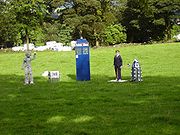
Norland, West Yorkshire
Encyclopedia
Norland is a scattered village
to the south of Sowerby Bridge
in the metropolitan borough of Calderdale
in West Yorkshire
, England
.
and Ryburn
rivers. These were gradually replaced in the 17th and 18th centuries by stone houses that mainly housed workers of the woollen industry which developed in the area at this time. As the industry thrived, some of the houses built by yeoman farmers were very substantial and remain excellent examples of their type, such as Lower Old Hall (dated 1634) and Fallingworth Hall (dated 1642). Norland Hall, lower down on the hillside near Milner Royd, was typical of an older timber-framed building encased in stone in the late 17th century. In 1911 it was struck by lightning and dismantled in 1914. The American newspaper magnate William Randolph Hearst
bought the stones in 1922 with the intention of re-building the hall in the USA. However, his plan came to nothing and eventually some of the material was incorporated into a chapel in San Simeon, California, in 1968.
The village has a church, St. Luke's, which opened in 1866. Three other places of worship, Mount Pleasant Methodist Chapel (1819–1962), Mount Zion Chapel and Bethel Baptist Chapel (1865-?), are now all private residences.
The primary school was originally built as a Sunday School
in 1871 and opened as a Church of England day school in January 1872. It has since been extended twice (1894 and 2003).
The War Memorial
was erected in 1920 and the park around it created four years later on the site of the old village pinfold. In 2000 a millennium sundial was added and a time capsule buried by the children of Norland school.
moorland, which rises to 284 metres (931.8 ft) at the trig point at the southern end. There is evidence of ancient use with a small number of standing stones, ditches and banks having been identified. The Ladstone, a large outcrop near the trig point, has been linked with the Druids as a possible place of ritual sacrifice (Celtic llad = kill or cut). The moor also bears the scars of quarrying on the north-western edge, which was carried out chiefly in the 18th and 19th centuries. The moor has been a popular place of recreation for generations but it has also attracted illegal gambling dens and prize fights!
Previously owned by Lord Savile, a large section of the moor was put up for auction in 1932 in order to pay death duties. The moor was purchased by local resident Mr Francis Longbottom for £250. Subsequently the Parish Council launched an appeal (which raised £373 in eleven days)and Norland Moor passed by dint of public subscription into the care of the Parish Council for the benefit of the local population. In 1937 control passed to Sowerby Bridge Urban District Council and then in 1974 into the newly formed Calderdale Metropolitan Borough Council. In 2002 Norland Moor was designated a Local Nature Reserve (LNR). In 2011 moves are in place to create a Friends of Norland Moor group so that local interests are still respected in the moor's management.
, "The Moorcock" and the Norland Working Men's Club
at Ivy Cottage in Stormer Hill Road, reputedly one of the smallest working men's clubs in the country. "The Blue Ball", dating back to at least the 1820s, closed in December 2009, and "The Hobbit" (previously "The West Bottom Tavern") closed in 2011.
festival was instigated by a millennium
committee for the village in 1999. It takes place on and around the first weekend in September. Every year a different theme for the event is set and many houses in the village create scarecrows along the lines of this theme and compete for the prize of best scarecrow. The theme for 2011 is Pop Stars and Groups.

Village
A village is a clustered human settlement or community, larger than a hamlet with the population ranging from a few hundred to a few thousand , Though often located in rural areas, the term urban village is also applied to certain urban neighbourhoods, such as the West Village in Manhattan, New...
to the south of Sowerby Bridge
Sowerby Bridge
Sowerby Bridge is a market town that lies within the Upper Calder Valley in the district of Calderdale in the county of West Yorkshire, in northern England.-Geography:Sowerby Bridge is situated on the edge of Halifax, about three miles from its centre...
in the metropolitan borough of Calderdale
Calderdale
The Metropolitan Borough of Calderdale is a metropolitan borough of West Yorkshire, England, through which the upper part of the River Calder flows, and from which it takes its name...
in West Yorkshire
West Yorkshire
West Yorkshire is a metropolitan county within the Yorkshire and the Humber region of England with a population of 2.2 million. West Yorkshire came into existence as a metropolitan county in 1974 after the passage of the Local Government Act 1972....
, England
England
England is a country that is part of the United Kingdom. It shares land borders with Scotland to the north and Wales to the west; the Irish Sea is to the north west, the Celtic Sea to the south west, with the North Sea to the east and the English Channel to the south separating it from continental...
.
History
The settlement dates back to the 13th century and consisted originally of timber-framed farmhouses situated on the hillside above the valleys of the CalderRiver Calder, West Yorkshire
The River Calder is a river in West Yorkshire, in Northern England.The Calder rises on the green eastern slopes of the Pennines flows through alternating green countryside, former woollen-mill villages, and large and small towns before joining the River Aire near Castleford.The river's valley is...
and Ryburn
River Ryburn
The River Ryburn is river in West Yorkshire, England. It flows through the villages of Rishworth, Ripponden and Triangle before flowing into the River Calder at Sowerby Bridge.-Course:...
rivers. These were gradually replaced in the 17th and 18th centuries by stone houses that mainly housed workers of the woollen industry which developed in the area at this time. As the industry thrived, some of the houses built by yeoman farmers were very substantial and remain excellent examples of their type, such as Lower Old Hall (dated 1634) and Fallingworth Hall (dated 1642). Norland Hall, lower down on the hillside near Milner Royd, was typical of an older timber-framed building encased in stone in the late 17th century. In 1911 it was struck by lightning and dismantled in 1914. The American newspaper magnate William Randolph Hearst
William Randolph Hearst
William Randolph Hearst was an American business magnate and leading newspaper publisher. Hearst entered the publishing business in 1887, after taking control of The San Francisco Examiner from his father...
bought the stones in 1922 with the intention of re-building the hall in the USA. However, his plan came to nothing and eventually some of the material was incorporated into a chapel in San Simeon, California, in 1968.
The village has a church, St. Luke's, which opened in 1866. Three other places of worship, Mount Pleasant Methodist Chapel (1819–1962), Mount Zion Chapel and Bethel Baptist Chapel (1865-?), are now all private residences.
The primary school was originally built as a Sunday School
Sunday school
Sunday school is the generic name for many different types of religious education pursued on Sundays by various denominations.-England:The first Sunday school may have been opened in 1751 in St. Mary's Church, Nottingham. Another early start was made by Hannah Ball, a native of High Wycombe in...
in 1871 and opened as a Church of England day school in January 1872. It has since been extended twice (1894 and 2003).
The War Memorial
War memorial
A war memorial is a building, monument, statue or other edifice to celebrate a war or victory, or to commemorate those who died or were injured in war.-Historic usage:...
was erected in 1920 and the park around it created four years later on the site of the old village pinfold. In 2000 a millennium sundial was added and a time capsule buried by the children of Norland school.
Norland Moor
Norland Moor (approx. 250 acres) above the village is a rare example of heatherErica
Erica ,the heaths or heathers, is a genus of approximately 860 species of flowering plants in the family Ericaceae. The English common names "heath" and "heather" are shared by some closely related genera of similar appearance....
moorland, which rises to 284 metres (931.8 ft) at the trig point at the southern end. There is evidence of ancient use with a small number of standing stones, ditches and banks having been identified. The Ladstone, a large outcrop near the trig point, has been linked with the Druids as a possible place of ritual sacrifice (Celtic llad = kill or cut). The moor also bears the scars of quarrying on the north-western edge, which was carried out chiefly in the 18th and 19th centuries. The moor has been a popular place of recreation for generations but it has also attracted illegal gambling dens and prize fights!
Previously owned by Lord Savile, a large section of the moor was put up for auction in 1932 in order to pay death duties. The moor was purchased by local resident Mr Francis Longbottom for £250. Subsequently the Parish Council launched an appeal (which raised £373 in eleven days)and Norland Moor passed by dint of public subscription into the care of the Parish Council for the benefit of the local population. In 1937 control passed to Sowerby Bridge Urban District Council and then in 1974 into the newly formed Calderdale Metropolitan Borough Council. In 2002 Norland Moor was designated a Local Nature Reserve (LNR). In 2011 moves are in place to create a Friends of Norland Moor group so that local interests are still respected in the moor's management.
Norland today
Norland today has an estimated population of about 600 (compared to about 1500 in the mid 19th century). Most people commute out of the village to work. It no longer has any shops but has one public housePublic house
A public house, informally known as a pub, is a drinking establishment fundamental to the culture of Britain, Ireland, Australia and New Zealand. There are approximately 53,500 public houses in the United Kingdom. This number has been declining every year, so that nearly half of the smaller...
, "The Moorcock" and the Norland Working Men's Club
Working men's club
Working men's clubs are a type of private social club founded in the 19th century in industrial areas of the United Kingdom, particularly the North of England, the Midlands and many parts of the South Wales Valleys, to provide recreation and education for working class men and their families.-...
at Ivy Cottage in Stormer Hill Road, reputedly one of the smallest working men's clubs in the country. "The Blue Ball", dating back to at least the 1820s, closed in December 2009, and "The Hobbit" (previously "The West Bottom Tavern") closed in 2011.
Norland Scarecrow Festival
The annual Norland scarecrowScarecrow
A scarecrow is, essentially, a decoy, though traditionally, a human figure dressed in old clothes and placed in fields by farmers to discourage birds such as crows or sparrows from disturbing and feeding on recently cast seed and growing crops.-History:In Kojiki, the oldest surviving book in Japan...
festival was instigated by a millennium
Millennium
A millennium is a period of time equal to one thousand years —from the Latin phrase , thousand, and , year—often but not necessarily related numerically to a particular dating system....
committee for the village in 1999. It takes place on and around the first weekend in September. Every year a different theme for the event is set and many houses in the village create scarecrows along the lines of this theme and compete for the prize of best scarecrow. The theme for 2011 is Pop Stars and Groups.


